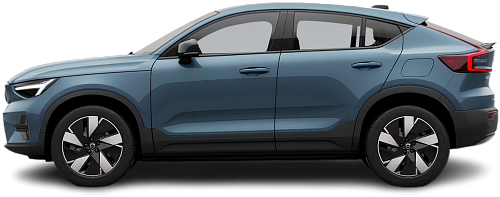Global EV Comparison: Volvo C40 Recharge (EC40) Twin Pure Electric vs Genesis GV60 Advanced AWD
Struggling to Decide? Let AI Help!
Your AI Summary Is Ready!
General Info
Since both vehicles have been discontinued, they are now only available on the used car market. You can get the Volvo C40 Recharge (EC40) Twin Pure Electric (2021-2022) for as low as €36900, while the Genesis GV60 Advanced AWD (2022-2025) begins at €38900.
The two vehicles share the same body style: SUV.
| Property | Volvo C40 Recharge (EC40) Twin Pure Electric | Genesis GV60 Advanced AWD |
|---|---|---|
| Years of Production | 2021-2022 | 2022-2025 |
| Current Status | Discontinued | Discontinued |
| Country of Manufacture | Belgium | South Korea |
| Body Style | SUV | SUV |
| Market Availability | EU, USA | EU, USA |
| Price Europe (Used) | €36900 | €38900 |
| GCC Score | 6.3 | 6.8 |
Range and Efficiency
Even though the Volvo C40 Recharge (EC40) Twin Pure Electric (2021-2022) has a larger battery, the Genesis GV60 Advanced AWD (2022-2025) higher energy efficiency results in a longer real-world driving range.
| Property | Volvo C40 Recharge (EC40) Twin Pure Electric | Genesis GV60 Advanced AWD |
|---|---|---|
| Range (EPA) | 364 km | 399 km |
| Range (WLTP) | 449 km | 470 km |
| Range (GCC) | 362 km | 389 km |
| Battery Capacity (Nominal) | 78 kWh | 77.4 kWh |
| Battery Capacity (Usable) | 75 kWh | 74 kWh |
| Efficiency per 100 km | 20.7 kWh/100 km | 19 kWh/100 km |
| Efficiency per kWh | 4.83 km/kWh | 5.26 km/kWh |
| Range and Efficiency Score | 5.4 | 6.3 |
Charging
The Genesis GV60 Advanced AWD (2022-2025) features an advanced 800-volt architecture, whereas the Volvo C40 Recharge (EC40) Twin Pure Electric (2021-2022) relies on a standard 400-volt system.
The Genesis GV60 Advanced AWD (2022-2025) offers faster charging speeds at DC stations, reaching up to 233 kW, while the Volvo C40 Recharge (EC40) Twin Pure Electric (2021-2022) maxes out at 150 kW.
Both vehicles are equipped with the same on-board charger, supporting a maximum AC charging power of 11 kW.
| Property | Volvo C40 Recharge (EC40) Twin Pure Electric | Genesis GV60 Advanced AWD |
|---|---|---|
| Max Charging Power (AC) | 11 kW | 11 kW |
| Max Charging Power (DC) | 150 kW | 233 kW |
| Architecture | 400 V | 800 V |
| Charge Port | CCS Type 2 | CCS Type 2 |
| Charging Score | 6.4 | 7.7 |
Performance
Both vehicles are all-wheel drive.
The Volvo C40 Recharge (EC40) Twin Pure Electric (2021-2022) boasts greater motor power and accelerates faster from 0 to 100 km/h.
| Property | Volvo C40 Recharge (EC40) Twin Pure Electric | Genesis GV60 Advanced AWD |
|---|---|---|
| Drive Type | AWD | AWD |
| Motor Type | PMSM (front), PMSM (rear) | PMSM (front), PMSM (rear) |
| Motor Power (kW) | 300 kW | 234 kW |
| Motor Power (hp) | 402 hp | 314 hp |
| Motor Torque | 660 Nm | 605 Nm |
| 0-100 km/h | 4.7 s | 5.5 s |
| Top Speed | 180 km/h | 200 km/h |
| Performance Score | 5.6 | 5.3 |
Dimensions
The Volvo C40 Recharge (EC40) Twin Pure Electric (2021-2022) and Genesis GV60 Advanced AWD (2022-2025) are about the same size.
The Genesis GV60 Advanced AWD (2022-2025) boasts a more extended wheelbase.
| Property | Volvo C40 Recharge (EC40) Twin Pure Electric | Genesis GV60 Advanced AWD |
|---|---|---|
| Length | 4440 mm | 4515 mm |
| Width (with Mirrors) | 2034 mm | - Width (with Mirrors) |
| Width (w/o Mirrors) | 1873 mm | 1890 mm |
| Height | 1596 mm | 1580 mm |
| Wheelbase | 2702 mm | 2900 mm |
Cargo and Towing
The Genesis GV60 Advanced AWD (2022-2025) provides more cargo capacity, featuring both a larger trunk and more space with the rear seats folded.
A frunk (front trunk) is available in the Volvo C40 Recharge (EC40) Twin Pure Electric (2021-2022), but the Genesis GV60 Advanced AWD (2022-2025) doesn’t have one.
The Volvo C40 Recharge (EC40) Twin Pure Electric (2021-2022) is better suited for heavy loads, offering a greater towing capacity than the Genesis GV60 Advanced AWD (2022-2025).
| Property | Volvo C40 Recharge (EC40) Twin Pure Electric | Genesis GV60 Advanced AWD |
|---|---|---|
| Number of Seats | 5 | 5 |
| Curb Weight | 2132 kg | 2095 kg |
| Cargo Volume (Trunk) | 404 l | 432 l |
| Cargo Volume (Max) | 1205 l | 1460 l |
| Cargo Volume (Frunk) | 31 l | - Cargo Volume (Frunk) |
| Towing Capacity | 1800 kg | 1600 kg |
| Cargo and Towing Score | 6.4 | 6.3 |




